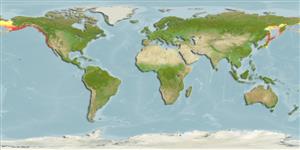Classificação / Names
Common names from other countries
Referência principal
Tamanho / Peso / Idade
Max length : 122 cm TL macho/indeterminado; (Ref. 96339); common length : 60.0 cm TL macho/indeterminado; (Ref. 5504); Peso máx. publicado: 25.4 kg (Ref. 7251); Idade máx. registada: 11 anos (Ref. 12193)
Length at first maturity
Lm ? range ? - ? cm
Ambiente
; marinhas; Água doce; estuarina bentopelágico; anádromo (Ref. 51243); intervalo de profundidade 0 - 200 m (Ref. 50550)
Clima / Intervalo
Subtropical; 10°C - 24°C (Ref. 12741), preferred 8°C (Ref. 107945); 67°N - 32°N, 135°E - 117°W
Distribuição
Native to Pacific Slope from Kuskokwim River, Alaska to (at least) Rio Santa Domingo, Baja California, Mexico; upper Mackenzie River drainage (Arctic basin), Alberta and British Columbia in Canada; endorheic basins of southern Oregon, USA. Widely introduced in cold waters elsewhere in North America and rest of the world (Ref. 5723). Eastern Pacific: Kamchatkan Peninsula and have been recorded from the Commander Islands east of Kamchatka and sporadically in the Sea of Okhotsk as far south as the mouth of the Amur River along the mainland. The records outside Kamchatka probably represent migrating or straying Kamchatkan steelhead (penshinensis) rather than the established native population (Reg. 50080). Several countries report adverse ecological impact after introduction.
Países | Áreas FAO | Ecossistemas | Ocorrências | Introduções
Descrição breve
Espinhos dorsais (total): 0; Raios dorsais moles (total): 10-12; Espinhos anais 0; Raios anais moles: 8 - 12; Vértebras: 60 - 66. Body elongate, somewhat compressed especially in larger fish. No nuptial tubercles but minor changes to head, mouth and color occur especially in spawning males. Coloration varies with habitat, size, and sexual condition. Stream residents and spawners darker, colors more intense. Lake residents lighter, brighter, and more silvery. Caudal fin with 19 rays (Ref. 2196). Differs from Oncorhynchus gorbuscha by having the following unique characters: by having the following unique characters: anal fin with 6-9½ (usually 8½ ) branched rays; 115-130 scales in midlateral row; 16-17 gill rakers; breeding males lacking hump; juveniles lacking parr marks; wide pink to red stripe from head to caudal base, except in sea-run form; and juveniles with 5-10 parr marks (Ref. 59043).
Categoria na Lista Vermelha da IUCN (Ref. 115185)
Ameaça para o homem
Potential pest
Utilização humana
Pescarias: altamente comercial; Aquacultura: espécies comerciais; peixe desportivo: sim
Ferramentas
Relatórios especiais
Descarregue XML
Fontes da internet
Estimates of some properties based on models
Phylogenetic diversity index
PD50 = 0.5000 many relatives (e.g. carps) 0.5 - 2.0 few relatives (e.g. lungfishes)
Nível Trófico
4.1 ±0.3 se; Based on diet studies.
Resiliência
Médio, tempo mínimo de duplicação da população 1,4 - 4,4 anos (K=0.38-0.46; tm=2-5; tmax=11; Fec=200)
Vulnerabilidade
Moderate vulnerability (36 of 100)
Categoria de preço
